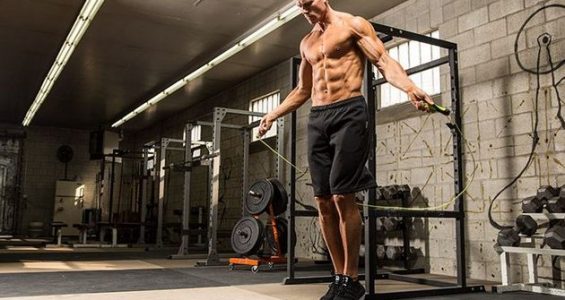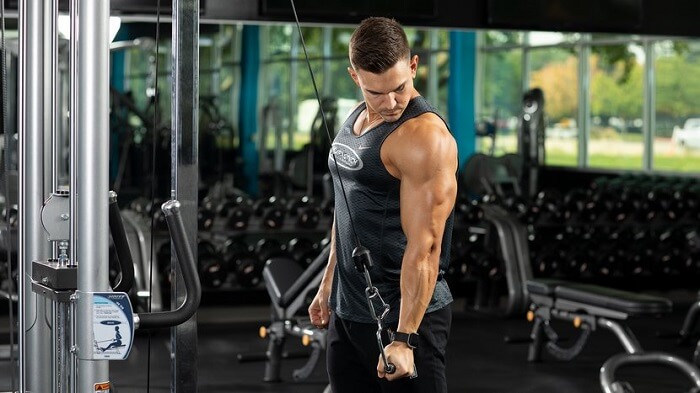DOES THE PECTORAL OPERATE TWICE A WEEK?
Doing a chest twice a week in bodybuilding seems to be the standard for many practitioners. However, this could be a error. Worse, it can limit your progress and increase your risk of injury. Don’t you believe me?
Based on my experience as a trainer and after teaching several thousand students, I will explain to you who really needs to work on breasts twice a week, and especially how to balance the “effects” of the negatives “of this practice … This article can be extrapolated to the point of logic: I will develop other muscles at work if the need arises.
PS: This article is for muscle building and is intended for natural practitioners, i.e. no doping.

1 is the correct frequency to run
When you start resistance training, the emphasis should be on training frequency, that is, to adopt the so-called FullBody program (see this article). The FullBody program consists of full body work in each session 2 to 3 times per week.
Thus, the pectoral muscles work twice (at least) a week, but also for all the major muscles. One or two exercises on the muscle “only”, because it would be impossible to do more without dramatically increasing the duration of the session. Here’s a Fullbody example to depict this:
| Monday – Wednesday – Friday | FullBody Bodybuilding Program |
| Joint mobilization | 5 minutes |
| Designed Rejected | 4 sets of 8-12 reps |
| Seated row with low pulley on top | 4 sets of 8-12 reps |
| Side Dumbbell Raise | 4 sets of 12-20 reps |
| Slanted Curl | 4 sets of 10 to 20 reps |
| Sedentary Neck Extension | 4 sets of 8-12 reps |
| Hip Press | 4 sets of 8-12 reps |
| Seated Leg Curl | 4 sets of 8-12 reps |
| Sitting calves | 4 sets of 10 to 20 reps |
| Ground Crisis | 4 sets of 12-30 reps |
| Stretching | 5 minutes |
This is the best program to do when you start strength training as it allows you to speed up the learning of exercises by repeating them often, knowing that the increase in strength in training comes from nervous gain, that is, from better inter- and intramuscular synchronization.
This way, you can save time before you can get to work and work the chest twice a week. Best seen three times when you start.
2 – Work your pectoral muscles twice a week if they are a weak point?
As we progress in strength training, our muscles do not develop at the same rate or the same. Strengths are established while other muscles are amnesic despite our efforts, so we’re talking about weaknesses.
Despite the fact that can be predicted its strengths and weaknesses in advance, thanks to morpho-anatomical analysis (you can do the analysis here) So, in order to adapt your program from the beginning, it is true that this approach is little known.

This does not in any way prevent the onset of weak points, but it does anticipate weak points by acting upstream by limiting muscle imbalance and reducing the risk of injury. In spite of everything, the weak point remains a weak point for life, and therefore, when we want to get the most balanced physique, that is, according to its definition, we must adapt our program accordingly
This is why working with pectoral mice twice a week can be helpful to optimize their development if they were a weak point for you. You can read this full article on how to catch up on weaknesses.
For this, the work of the agonist muscles, that is, the deltoids and triceps, must be reduced to minimum so that the pectoral muscles can recover at their best and so that you have maximum energy when you work with them. It would even be ideal if they worked in the same session so as not to interfere with the workouts intended for the chest muscles.
We could then present a training distribution like PPL (see this article) to group the agonist work. An example of a program might be the following, starting with the morpho-anatomical postulate that you are a “grasshopper” or “gorilla” (you can see my classification here):
| Twice a week nursing program | |
| Monday | |
| Joint mobilization | 5 minutes |
| Designed with bar | 4 sets of 8-12 reps |
| Dumbbell Press | 4 sets of 8-15 reps |
| Step out from opposite pulley | 4 sets of 15-30 reps |
| Bird with dumbbells on an incline bench | 4 sets of 12 to 40 reps |
| Magic Triceps | 4 sets of 12-20 reps |
| Triceps extension to overhead pulley | 4 sets of 12-20 reps |
| Tuesday | |
| Joint mobilization | 5 minutes |
| High traction pulley with wide front grip | 4 sets of 8-12 reps |
| Incline Dumbbell Row | 4 sets of 8-12 reps |
| Seated row with low pulley in neutral clutch | 4 sets of 15-20 reps |
| L-Fly sits on low pulley | 4 sets of 15-20 reps |
| Slanted Curl | 4 sets of 10 to 20 reps |
| Gripping hammer handle | 4 sets of 10 to 20 reps |
| Tummy Enlargement – Plank | 4 sets of 1 minute |
| Stretching | 5 minutes |
| Thursday | |
| Joint mobilization | 5 minutes |
| Front Squat | 4 sets of 8-12 reps |
| Slots with back legs on bench | 4 sets of 10-15 reps |
| Standing Leg Curl | 4 sets of 10-15 reps |
| Semi-tensioned thrust rods | 4 sets of 8-12 reps |
| Thigh Calf | 4 sets of 12-20 reps |
| Crunch | 4 sets of 1 minute |
| Pool Tape | 4 sets of 10-15 reps |
| Stretching | 5 minutes |
| Friday | |
| Joint mobilization | 5 minutes |
| Dumbbell Press | 4 sets of 8-12 reps |
| Lying spread with dumbbells | 3 sets of 10-15 reps |
| Pullover through the bench | 3 sets of 15-20 reps |
| Side height with dumbbells | 4 sets of 10-15 reps |
| Spring dips | 4 sets of 8-12 reps |
| Rope extension of the triceps to high pulley | 4 sets of 10-20 reps |
| Inclined cladding | 4 sets of 1 minute |
| Stretching | 5 minutes |
The only difference with the classic PPL bodybuilding doubles push-ups to train the chest twice a week. You may also see a slightly reduced training volume for the deltoid and triceps.
The program does not include a bench press, because if the pectoral muscles are a weak point for you, the chances are high that you are not made for it. So there is no reason to do this.
From experience, working on weaknesses twice a week is the right frequency for making progress. Finally, solving weaknesses in bodybuilding is not for beginners.
3 – What is the risk of injury when nursing twice a week?
Working with breasts twice a week in strength training significantly increases the risk of injury, especially in the shoulder area. Indeed, in order to have “healthy” joints, one of the basic rules is to have equal strength on each side, balance .
This means that you have to push as much as you pull, do as much bench press as you pull, and especially at the same angles to reduce possible rotator cuff pathologies, small muscle groups are responsible for stabilizing the joint by acting as active “bundles”.

However, if someone emphasizes the work of the pectoral muscles to the detriment of the work of the back, in particular the development of the middle and lower trapeziums, the prickly infra-region, he gradually exposes himself to adopting a posture. where the shoulders are strongly directed forward , and the upper back “develops” hyperkyphosis.
This “bad” posture further reduces the potential of chest development and their demands on bench press exercises such as the bench press, because then it is no longer possible to adopt good technique to maintain ” chest “, released during the series, is a prerequisite to be able to use them well.
This is one of the tracks that I explain and demonstrate using the solutions in my super pectoral workout. This implies a lack of mobility of the internal rotator muscles of the shoulder joint and the inability to engage external rotation, which severely limits the adoption of good indicators that promote safe muscle growth, not just the pectoral muscles.
Breastfeeding twice a week is therefore not so trivial. That is why it must be balanced if the situation lasts more than a few months, by adding a stretching exercise, in particular rowing, local work of external rotation of the shoulder and posterior bundle of the deltoid muscle.
Since working twice a week with bibs is a classic and often overused for several years in a row, I have come to establish a simple rule for shoulder health. (Which would be a good start):
Twice as many prints as developed. This also means that in the long run you will be doing lessons twice a week. The bench press exercise involves doing two rowing exercises.
In the example program above, this would mean at least six rowing exercises (they can be the same, but repeated several times a week if you don’t have a room) for a week, including birds. If you do not follow this rule, in the long term you will almost certainly suffer from abnormalities in the shoulders. If so, read this article.
4 – is it really necessary to work the chest straps twice a week?
When should the chest muscles work twice a week?
Whatever your morpho-anatomy, especially because of the habits we have every day; we are a reflection of it, we tend to have shoulders forward from the base, and the upper back is more rounded than necessary.
This is why I recommend that you do 1.5 times more stretching exercises, and in particular rowing , than exercises designed to keep your shoulders in good condition. operations.
Particular attention should be paid to carefully launching the deadlift exercises using the famous shoulder movement, which is responsible for the operation of the paddle locks and lowers. Stretching with your arms alone will not have the expected effect on the balance of power around your fragile shoulder joint. Of course, it can be scary to do so many back exercises.
Can we end up with a back too fat ? Personally, I doubt it and have never seen it, not even with professional bodybuilders. A thick back is also a guarantee of longevity in bodybuilding. So what to do with breasts twice a week in these conditions and with our habits? It’s like training your back even more time.
This is all the problematic that we have when we have weak pectoral muscles, regardless of whether we should emphasize the volume and frequency of learning from those who have seen all that is implied behind. Sometimes a better exercise choice over his morpho-anatomy, without changing his training frequency and volume, may be enough to change the situation.
This is why I invite you to start by wanting to do breast work twice a week.

5 – Conclusion
Working on chest muscles twice a week in bodybuilding is not a obligation and not for everyone. It depends on the morpho-anatomy of each person, as well as on his priorities. Defining your goals remains the foundation for knowing and personalizing your learning to improve your progress. Hopefully I’ve helped you see the work of the nurses more clearly twice a week.
